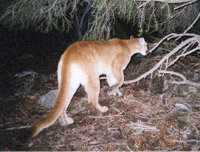Main Content
Article
Mountain Lion

Photo from National Park Service.
The mountain lion (Puma concolor) is sometimes called cougar, puma, catamount, and panther. Mountain lions once lived in much of the eastern United States. They were extirpated from Indiana by the late 1800s.
The DNR maintains mountain lion sightings using a system to receive, record and review mountain lion reports. The only confirmed mountain lion reports were in fall 2009 in southern Clay County and spring 2010 in northern Greene County. It is not known if these reports were the same animal, but their proximity makes it possible they were. The DNR receives many mountain lion reports through this system. However, most sightings prove to be a species other than a mountain lion, are inconclusive, or are part of an internet hoax.
Indiana has no breeding population of mountain lions. However, data collected by the Cougar Network and other states over the past decade suggest mountain lions are appearing outside their traditional Western range. This may be the result of an increase in mountain lion numbers in Western states. Animals found outside of their Western range are usually young, transient males.
Mountain Lion, Bobcat, or Domestic Cat?

Bobcat
- Weight: 15-30 pounds
- Length: About 30-50 inches long
- Tail: About 4-5 inches long
Mountain Lion
- Weight: 80-160 pounds
- Length: About 7-8 feet long
- Tail: 2-3 feet long (up to half of the total length)
Identification
The mountain lion is a large, slender cat, with a long rope-like tail. Adults are a uniform tan or tawny in color, with a white or cream-colored chin, undersides and inner legs.
Bobcats, feral cats and domestic dogs may be misidentified as mountain lion. Below is a list of physical characteristics that distinguish mountain lions from more common species.
Physical appearance
- Coat overall is tawny to golden-brown
- Long, thick tail with blunt, black tip that is held low, not uplifted
- Oval heads are smaller in proportion to their overall body size
- Longer neck in comparison to housecats; the neck can be as long as the length of the head
- Rounded ears that are solid black or gray on the back, may have a white or light spot
- Some black on the front of the muzzle, below the nose
- Belly, underside, inside legs and chin are white or creamy
- Slight sag to their spine
NOTE: Use of optics (binoculars or scopes) can magnify an animal's size.
Tracks
- Approximately 3-4 inches in length and 3-4.5 inches wide
- Round and often wider than they are long
- No claws

Front Track

Back Track
Report a large mammal sighting
Only reports including a clear, verifiable picture of a mountain lion in a verifiable location; a picture or plaster cast of mountain lion tracks; or other evidence of specific mountain lion behavior will be field investigated. Others will be entered into the database as unconfirmed reports. To report a mountain lion sighting or encounter use this online large mammal report form.
If you encounter a mountain lion
The prospect of mountain lions alarms many citizens; however, the likelihood of encountering a mountain lion in Indiana is remote. The same is true even in Western states with breeding populations because these are reclusive animals. There is little likelihood for this animal to be seen in large cities, neighborhoods and other areas where there are humans.
If an encounter does happen, follow this advice from authorities in Western states:
- Do not approach a mountain lion. Give it a way to escape.
- Do not run from a mountain lion. Instead, stand and face the animal. Make eye contact.
- Do not crouch or bend over. Do all you can to appear larger. Raise your arms and open your jacket or shirt. Wave your arms slowly and speak firmly in a loud voice.
- Hold children and pets near you.
- Fight back if attacked using big sticks, stones or any other available items.
Legal status
The mountain lion in Indiana is protected as an exotic mammal. State law allows a resident landowner or tenant to kill a mountain lion while it is causing damage to property owned or leased by the landowner or tenant. If the landowner/tenant wishes to have someone else kill the mountain lion, that person must get a permit from the DNR Division of Fish & Wildlife. Any mountain lion killed should be immediately reported to a DNR wildlife biologist or Central Dispatch of Indiana DNR Law Enforcement.
More information
Cougarnet.org provides an identification guide describing how to tell mountain lions from other animals.
